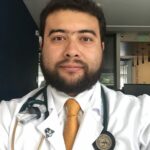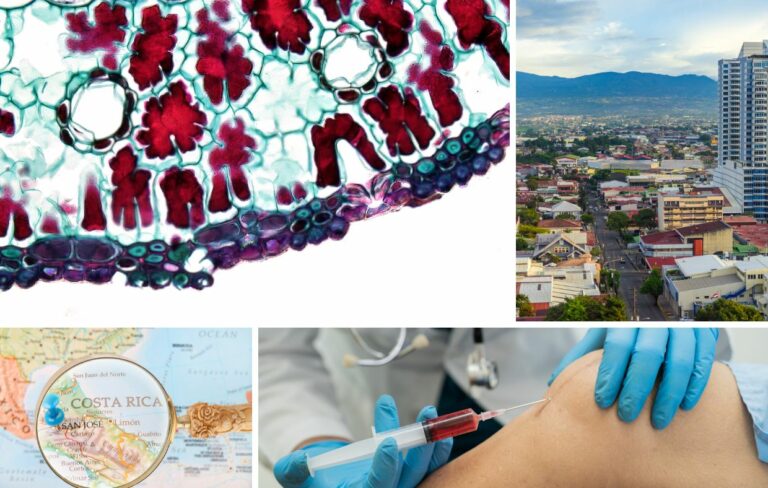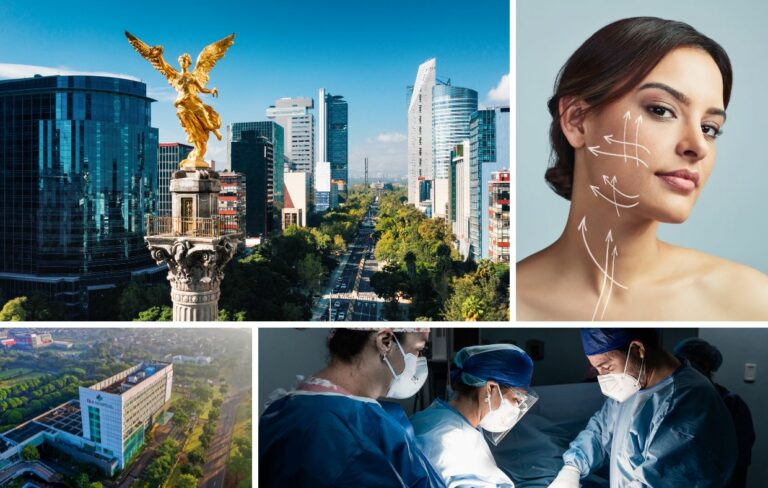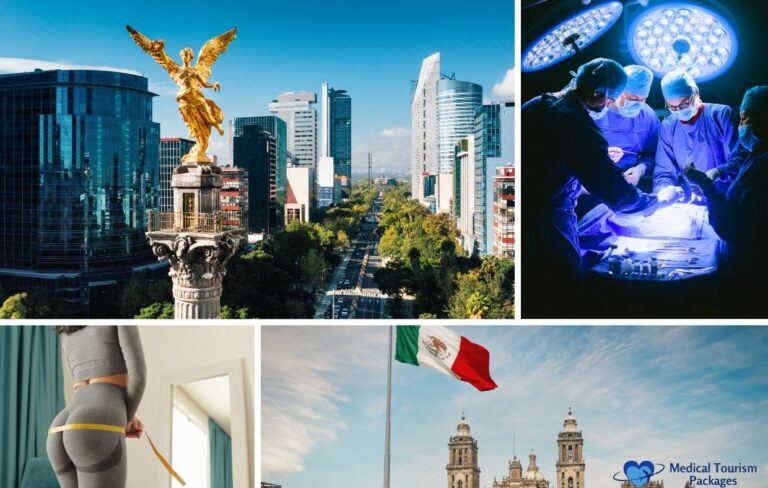Book Appointment Now
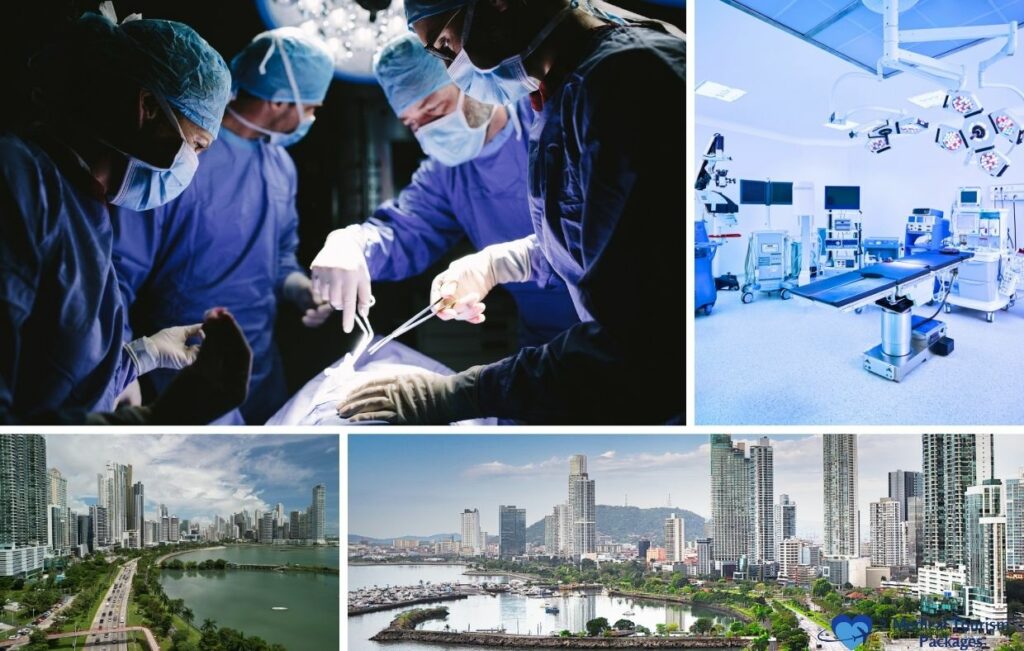
Your Complete Guide to Plastic Surgery in Panama
Panama has positioned itself as Latin America’s premium medical tourism destination for plastic surgery. While the country attracts approximately 50,000 annual medical tourists, far fewer than Mexico’s 1.2 million or Colombia’s high-volume market, Panama deliberately targets quality-conscious patients who prioritize safety validation over absolute lowest costs.
The value proposition is compelling: 50-70% savings compared to US prices, combined with JCI-accredited hospitals, Johns Hopkins Medicine International affiliation, and a dollarized economy eliminating currency risk. A breast augmentation costing $8,000-$10,000 in the US runs $3,000-$5,000 in Panama. A tummy tuck priced at $8,500-$12,000 domestically costs $3,500-$6,500.
This guide covers everything you need to know about getting plastic surgery in Panama: cost comparisons, surgeon credentials, hospital accreditation, procedure options, recovery protocols, and critical safety considerations for 2025. For additional information on medical tourism in Panama, see our complete guide for American medical tourists.
Why Choose Panama for Plastic Surgery?
Panama offers a unique combination that distinguishes it from regional competitors: significant cost savings meet internationally validated safety standards, Johns Hopkins institutional relationships, and complete currency stability—all within five hours’ flight from major North American cities.
How Much Can You Actually Save in Panama?
Recent analysis reveals Panama’s deliberate positioning. The country attracts 50,000 annual medical tourists, with approximately 20,000 seeking plastic surgery specifically. Two hospitals hold JCI accreditation, matching Costa Rica and Argentina. Hospital Punta Pacifica maintains the only Johns Hopkins affiliation in Central America. Only 12 surgeons hold FACS or FRCSC certification, representing the elite credential tier.
Patients come predominantly from the US and Canada, representing 60-70% of the medical tourism market. The plastic surgery sector generated an estimated $62.5 million in revenue during 2024, with projections showing 18.9% annual growth reaching 17,770 patients by 2025.
Panama operates on a fundamentally different scale than Colombia or Mexico. Rather than competing on volume, the country emphasizes quality assurance through institutional validation markers that appeal to risk-averse patients.
Who Chooses Panama for Plastic Surgery?
Research shows specific demographics favor Panama. Professionals and managers prioritizing safety over bargain prices make up the core patient base. Patients requiring currency stability for predictable budgeting appreciate the dollarized economy. Those seeking multiple procedures like mommy makeovers or comprehensive body contouring find package pricing attractive. The typical patient can accommodate 2-3 weeks for proper recovery and feels comfortable conducting thorough credential verification.
How Much Money Can You Save Compared to the US?
Cost savings run 50-70% compared to US prices. Unlike destinations where currency volatility adds uncertainty, Panama’s dollarized economy means your $5,000 quote remains exactly $5,000 at payment—no exchange rate surprises.
Panama vs USA Price Comparison
| Procedure | Panama Range | USA Range | Savings |
|---|---|---|---|
| Breast Augmentation | $3,000–$5,000 | $8,000–$10,000 | 60% |
| Tummy Tuck | $3,500–$6,500 | $8,500–$12,000 | 65% |
| Brazilian Butt Lift | $3,500–$7,000 | $9,000–$13,000 | 60% |
| Liposuction | $2,000–$5,000 | $6,000–$8,500 | 50% |
| Mommy Makeover | $6,000–$10,000 | $12,000–$18,000 | 50% |
| Facelift | $3,000–$6,000 | $7,500–$10,000 | 70% |
| Rhinoplasty | $2,500–$5,500 | $7,500–$10,000 | 55% |
Regional Comparison: Panama’s Premium Positioning
| Procedure | Panama | Colombia | Mexico | Costa Rica |
|---|---|---|---|---|
| Breast Augmentation | $3,000–$5,000 | $2,500–$4,500 | $2,500–$5,000 | $3,000–$5,000 |
| Tummy Tuck | $3,500–$6,500 | $3,000–$5,000 | $3,000–$7,000 | $3,500–$6,500 |
| BBL | $3,500–$7,000 | $3,000–$6,000 | $3,500–$7,000 | $3,500–$7,000 |
Panama’s price floor runs $500-$1,500 higher than Colombia’s minimums, reflecting premium positioning through JCI accreditation and Johns Hopkins standards rather than competing solely on price.
How Do You Verify a Surgeon’s Credentials in Panama?
The gold standard is APCPER (Asociación Panameña de Cirugía Plástica Estética y Reconstructiva) membership. This organization maintains the official registry of qualified, board-certified surgeons in aesthetic, plastic, and reconstructive surgery. Only 12 surgeons hold American FACS (Fellow of the American College of Surgeons) or Canadian FRCSC (Fellow of the Royal College of Surgeons of Canada) certification—the highest credential tier available.
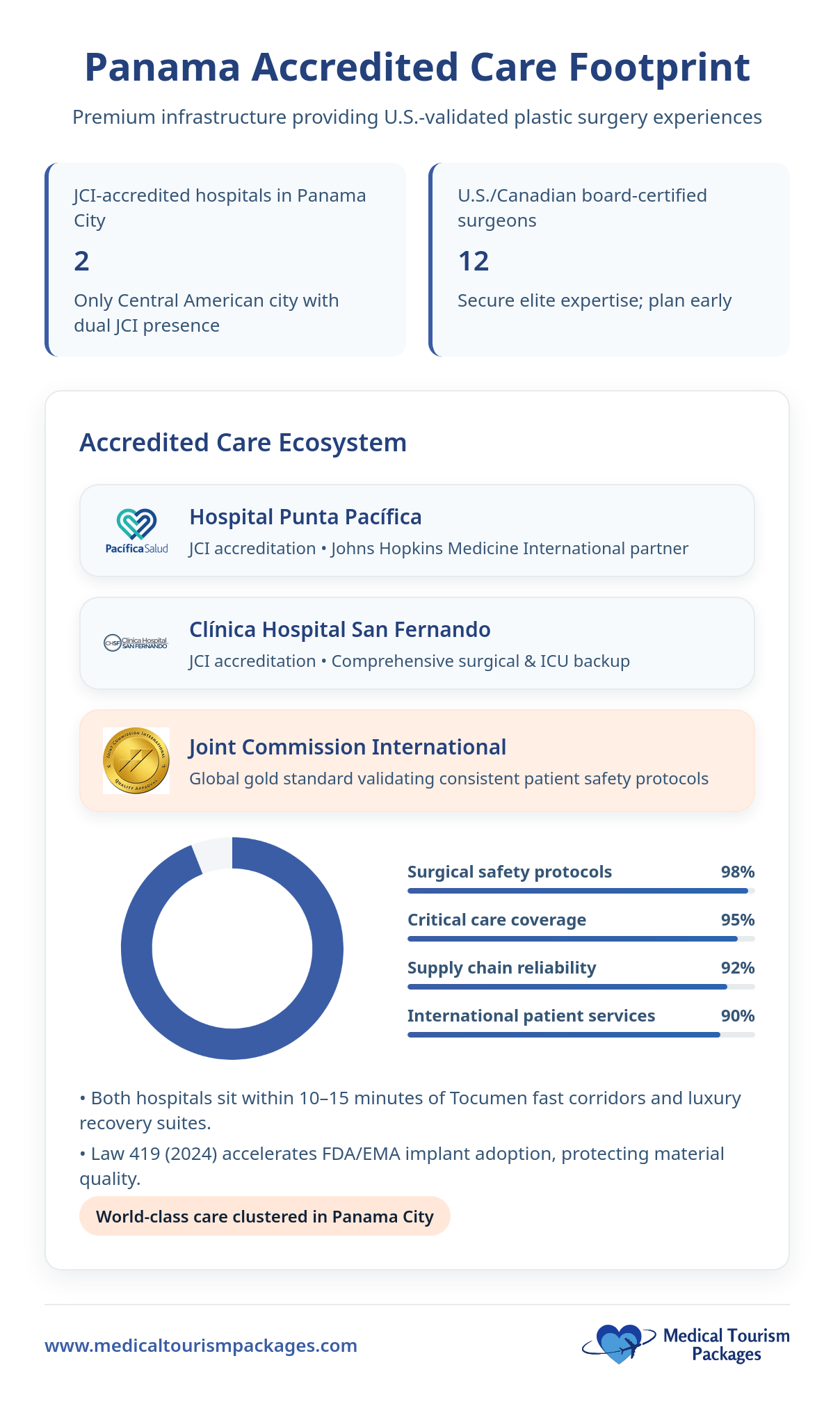
You must verify any surgeon’s APCPER membership yourself through their official registry. Do not rely solely on clinic marketing or websites. Top surgeons typically completed US or European training at institutions like Mayo Clinic and maintain operating privileges at JCI-accredited hospitals.
Dr. Jacqueline Richa exemplifies elite credentials as Panama’s first and only plastic surgeon trained at Mayo Clinic, specializing in both complex restorative operations and high-demand aesthetic procedures. Patient reviews consistently highlight personalized attention and meticulous surgical results.
Which Hospitals in Panama Are Actually Safe?
Panama features two JCI-accredited facilities for plastic surgery. Hospital Punta Pacifica holds JCI accreditation and the only Johns Hopkins Medicine International affiliation in Central America. This institutional relationship ensures clinical governance and operational procedures conform to US academic medical standards. The facility offers advanced equipment including VASER, BodyTite, and Renuvion J-Plasma technologies in a modern urban environment near hotels and recovery facilities.
Clinica Hospital San Fernando was the first hospital in Panama to achieve JCI accreditation. The facility provides comprehensive services across all specialties with an established track record serving international patients. Full ICU and emergency capabilities ensure proper infrastructure for managing any complications.
JCI accreditation guarantees stringent international safety protocols and sterilization standards, mandatory outcome monitoring and complication tracking, and access to ICU and emergency departments with 24/7 specialist coverage. Accredited facilities provide international warranty coverage for FDA and EMA-approved implants and undergo regular external auditing by independent inspectors.
What Safety Laws Protect Plastic Surgery Patients in Panama?
Panama’s regulatory system provides substantial patient protection. The Ministry of Health (MINSA) oversees all medical practice in the country. Executive Decree No. 83 from 2019 requires 10-year marketing authorization for all medical devices, ensuring surgical implants and instruments undergo regulatory review before market entry.
Law 419, enacted in February 2024, established expedited approval for FDA and EMA-approved products. This regulatory alignment ensures patients receive the same quality implants and surgical materials available in the United States or Europe. The Directorate of Pharmacy and Drugs specifically regulates cosmetic products, dermal fillers, implants, and medical consumables used in aesthetic procedures.
JCI standards enforce comprehensive patient safety measures at accredited facilities, including standardized surgical checklists, medication verification procedures, infection prevention protocols, patient identification systems, and systematic complication tracking. Enhanced infection-control protocols maintained since COVID-19 provide an additional safety margin beyond pre-pandemic standards.
What Procedures Can You Get in Panama?
Panama offers extensive plastic surgery options across major categories:
Body Contouring Procedures:
- Liposuction (traditional, VASER ultrasound-assisted, BodyTite radiofrequency)
- Tummy tuck (abdominoplasty)
- Brazilian butt lift (BBL)
- Mommy makeover packages
- Body lifts (upper, lower, full body)
Breast Procedures:
- Augmentation with premium implants (Mentor, Allergan, Motiva, Eurosilicone)
- Breast lift (mastopexy)
- Breast reduction
- Breast reconstruction
Facial Procedures:
- Facelift (rhytidectomy)
- Rhinoplasty (nose reshaping)
- Eyelid surgery (blepharoplasty)
- Brow lift
- Neck lift
Male-Specific Procedures:
- Gynecomastia correction (male breast reduction)
- Male liposuction
- Hair restoration
Advanced Technologies at JCI Hospitals: VASER ultrasound-assisted liposuction reduces trauma and accelerates recovery. BodyTite radiofrequency technology provides simultaneous skin tightening during fat removal. Renuvion J-Plasma offers minimally invasive skin tightening. Real-time ultrasound guidance ensures safe BBL fat injection placement.
Brazilian Butt Lift: Panama’s Safety Success Story
Panama implemented enhanced BBL safety protocols in 2018, specifically addressing the highest-risk cosmetic procedure. The result speaks for itself: zero BBL-related deaths at JCI hospitals since protocol implementation.
Mandatory Safety Protocols at JCI Facilities:
- Maximum injection volume ≤1,000 cc per side – Prevents excessive fat transfer increasing embolism risk
- Subcutaneous injection only – Fat remains above gluteal muscle; no deep or intramuscular injection
- Real-time ultrasound guidance – Visualizes injection depth throughout entire procedure
- Mandatory 24-hour ICU monitoring – All BBL patients receive intensive care observation post-operatively
- Strict patient selection criteria – Cardiovascular health, BMI, and fitness evaluated before approval
- Certified anesthesiologists – General anesthesia administered only by board-certified professionals
Critical Warning: Only consider JCI-accredited facilities for BBL procedures. Non-accredited clinics lack proper safety infrastructure, ultrasound guidance equipment, and ICU monitoring capabilities essential for this high-risk procedure. Even excellent surgeons face a 1:3,000 mortality rate with BBL under standard conditions, making facility choice absolutely critical.
The $3,500 to $7,000 cost range at JCI facilities reflects different surgeon experience levels and technique sophistication. Higher prices typically indicate surgeons with extensive BBL-specific training and perfect safety records. Recovery from BBL requires the full 14-day stay in Panama due to the extended fat embolism risk window.
What’s Included in All-Inclusive Surgery Packages?
All-inclusive packages bundle surgical costs with support services to simplify the medical tourism experience. Packages typically include the surgeon’s fee, anesthesiologist, operating room and equipment, facility fees, and FDA or EMA-approved implants or materials.
Accommodation coverage spans 7-14 days depending on the procedure, provided in recovery houses with nursing support, hotels near medical facilities, or wellness retreats for extended recuperation. Post-operative care includes daily nursing visits or 24/7 on-site support, lymphatic drainage sessions, post-operative massage, surgeon follow-up appointments, compression garments, wound care and dressing changes, and initial medications.
Transportation services cover VIP airport pickup and dropoff, ground transportation to all medical appointments, and coordination between hospital, hotel, and recovery locations. Support services include pre-operative virtual consultations, translation services during appointments, 24/7 emergency contact with the surgical team, personalized nutritional counseling, and home care instructions in English.
What packages typically don’t include: international flights, medical complication insurance (essential to purchase separately), standard travel insurance, meals beyond recovery house provisions, personal expenses and shopping, visa fees (though US and Canadian citizens receive 180-day visa-free entry), revision surgeries if needed, and treatment of complications.
What’s the Step-by-Step Process from Booking to Recovery?
Medical tourism to Panama follows a structured timeline from initial research through post-surgery follow-up. The entire process spans roughly four months: three months of preparation and vetting, followed by your 2-3 week stay in Panama for surgery and recovery. Understanding each phase helps you plan properly and avoid the mistakes that lead to complications or disappointing outcomes.
Phase 1: Research and Virtual Consultation (3 Months Before)
Begin by contacting selected surgeons for initial video consultations. You must verify surgeon credentials through APCPER directly—this step is mandatory. Request before-and-after photos specific to your procedure and discuss realistic expectations with each surgeon. Obtain medical clearance from your home doctor and request itemized package quotes from facilities. The three-month timeline ensures access to quality surgeons who maintain busy schedules.
Phase 2: Booking and Arrangements (1-2 Months Before)
Select your surgeon and facility, restricting choices to JCI-accredited hospitals only. Pay the required deposit, which typically ranges from 50-100% prepayment. Book round-trip flights with flexible dates to accommodate potential recovery timeline adjustments. Purchase medical complication insurance before making any deposits—this is non-negotiable.
Arrange recovery accommodation through the facility or independently. Stop smoking at least 4 weeks before surgery, as nicotine significantly impairs wound healing. Adjust medications per surgeon instructions, typically stopping blood-thinning medications 7-14 days pre-surgery. Secure at least 3 weeks off work, more for physically demanding jobs.
Phase 3: Arrival in Panama (Tuesday Recommended)
Arrive 2-3 days before surgery for necessary preparation. VIP airport pickup transfers you to your accommodation. The in-person consultation allows your surgeon to physically examine your anatomy and confirm the surgical plan. Final measurements and surgical markings occur during this visit. Pre-operative testing includes blood work and EKG if needed, with JCI hospitals providing on-site laboratory facilities for rapid results.
Sign consent forms in English and complete final payment processing. Surgery typically schedules for Thursday, allowing the two-day preparation period to ensure all testing is complete, you’ve rested after travel, and jet lag effects have diminished. Thursday surgery also allows for weekend recovery before Monday follow-up appointments.
Phase 4: Surgery Day
Arrive at the JCI-accredited hospital fasting per instructions. Final pre-operative checks confirm you’re ready for surgery. The surgical team confirms markings and answers any last questions. Your procedure occurs under general anesthesia with certified anesthesiologists. Post-operative monitoring lasts 24-48 hours in the hospital depending on procedure complexity. You then transfer to recovery accommodation with nursing support beginning immediately.
Phase 5: Recovery Period (7-14 Days in Panama)
The recovery timeline varies by procedure. Days 1-2 involve hospital observation with 24-48 hour monitoring. BBL patients receive mandatory ICU monitoring for 24 hours. Pain management protocols are established and drain care begins. Initial mobility exercises start despite discomfort to reduce blood clot risk.
Days 3-5 represent the critical phase. You move to the recovery house or hotel with daily nursing wound care. Lymphatic drainage sessions begin, typically lasting 30-60 minutes. The first surgeon follow-up appointment occurs on day 3 or 4. This period usually involves peak swelling and discomfort, though pain levels begin improving as initial inflammation subsides.
Days 6-10 bring stabilization. Continued lymphatic drainage occurs 2-3 times weekly. Post-operative massage improves circulation and reduces inflammation. Non-dissolvable sutures or staples are removed between days 7 and 10. Increased mobility becomes permitted, including short walks outside, though strenuous activity remains prohibited. Personalized nutritional counseling supports optimal healing.
Days 11-13 focus on flight clearance. A comprehensive final evaluation assesses whether healing has progressed adequately for air travel. If appropriate, the surgeon provides written clearance for international travel. Some patients need additional days if complications or slow healing occurred. You receive detailed home care instructions covering wound care, activity restrictions, medication schedules, warning signs of complications, and the follow-up timeline. The surgeon confirms proper compression garment fit and reviews the wearing schedule.
Phase 6: Departure and Long-Term Follow-Up
Return flights should include aisle seats for easier movement and frequent walking during the flight. Weekly telemedicine consultations with your Panama surgeon continue for the first month post-operatively. Submit photos at 2, 4, 8, and 12 weeks for remote assessment of healing progress.
Before traveling to Panama, identify a local doctor willing to provide emergency care for complications. Some physicians refuse to treat complications from overseas surgery, so securing this arrangement in advance prevents desperate searching if problems develop. Consider an optional return trip at 6 months for final in-person evaluation, which some surgeons include in packages or offer at reduced cost.
What Should You Know Before Booking Your Surgery?
Before committing to plastic surgery in Panama, you need realistic information about recovery timelines, medical tourism risks, and insurance requirements. Understanding these factors upfront prevents costly mistakes and helps you determine if Panama actually makes sense for your situation.
How Long Is Recovery for Each Procedure?
Breast augmentation requires 24-48 hours hospital stay and 7-14 days Panama recovery. Most patients return to desk work within 1-2 weeks, with full recovery taking 4-6 weeks. Tummy tuck involves 24-48 hours hospitalization and mandatory 12-14 day Panama recovery. Return to work typically requires 3-4 weeks, with heavy exercise restricted for 6-8 weeks and final results appearing over 6-12 months.
Brazilian butt lift mandates 24-hour ICU monitoring and a full 14-day Panama recovery period. No direct sitting for 2-3 weeks with special pillow required. Return to work takes 3-6 weeks with final results visible at 6 months. Mommy makeover requires 24-48 hours hospital stay and 14-21 days Panama recovery, with return to work at 4-6 weeks, no heavy lifting for 6+ weeks, and final results at 12 months.
What Are the Real Risks of Getting Surgery in Panama?
All surgery carries inherent risks including infection, bleeding, anesthesia complications, scarring, asymmetry, and potentially disappointing results. Medical tourism adds specific considerations that differ from domestic surgery.
Travel-related risks include deep vein thrombosis from long flights post-surgery, with blood clot risk amplified by surgical immobilization. Surgical site infections may involve unusual bacteria due to different environments or varying standards outside JCI facilities. Language barriers can occur despite translation services, potentially causing misunderstandings about care instructions.
Follow-up challenges create significant concerns. Local doctors may refuse treatment for overseas complications, viewing these cases as high-risk with unclear liability. Revision surgeries in the US often cost more than the original procedure performed abroad. Legal recourse remains limited to Panamanian jurisdiction, with litigation prohibitively expensive and complex for foreign nationals.
Quality variations exist dramatically between JCI and non-accredited facilities. Limited transparency in complication rates makes assessment difficult. The pool of only 12 elite-credentialed surgeons requires careful vetting. General travel risks include crime or regional health issues—check government travel advisories for current safety information.
Medical Complication Insurance: Non-Negotiable Protection
Standard travel insurance does not cover surgical complications from elective procedures. This exclusion leaves you financially exposed if complications arise.
You must purchase specialized medical tourism insurance covering treatment of surgical complications both in Panama and your home country. Policies should provide high coverage limits of at least $25,000, with many experts recommending higher. Extended duration of 180+ days post-operative ensures protection during the full healing period. Coverage should include emergency evacuation if needed and extended stay accommodation if complications prevent travel as scheduled.
Estimated costs for comprehensive coverage run $150-$300. This insurance is non-negotiable. Complications without insurance can cost tens of thousands of dollars and cause financial devastation that eliminates any savings from choosing medical tourism.
Why Does Panama Use the US Dollar and Why Does It Matter?
Panama uses the US dollar as its official currency, making it unique among major Latin American medical tourism destinations. This provides zero exchange rate risk—your $5,000 quote remains exactly $5,000 at payment with no surprises. Credit cards don’t charge foreign transaction fees since transactions occur in US dollars. You can plan costs with complete accuracy months in advance through simplified budgeting. ATMs dispense US dollars at standard rates with no exchange surprises.
Comparison to competitors highlights this advantage. Colombia’s peso swings 15-20% monthly during volatile periods. A $4,000 procedure could become $4,800 if the peso strengthens 20% between booking and surgery. Mexico’s peso dropped 30% in 2020, creating severe pricing unpredictability for that year’s medical tourists. Costa Rica’s colón shows moderate volatility—less dramatic than Colombia or Mexico but more uncertain than Panama’s dollar.
This currency stability particularly benefits patients with the recommended 3-month advance booking timeline, ensuring your financial analysis remains valid throughout the entire planning period.
How Do You Find and Verify a Qualified Surgeon?
Confirming APCPER membership represents your mandatory first step. Contact the Asociación Panameña de Cirugía Plástica Estética y Reconstructiva directly to verify active membership status, check for any disciplinary actions, and confirm years of practice. Do not rely on clinic websites or marketing materials for this critical verification.
Verify international credentials by requesting documentation of FACS or FRCSC certification. Confirm the specific US or European training institutions claimed. Contact training programs directly if necessary to verify residency completion.
Check JCI hospital privileges by confirming the surgeon operates at Hospital Punta Pacifica or Clinica Hospital San Fernando. Verify current privileges haven’t expired. Refuse surgeons operating exclusively in private clinics, as this arrangement compromises access to critical care infrastructure necessary for managing surgical emergencies.
Review procedure-specific experience by requesting the exact number of times your specific procedure has been performed. Review the before-and-after portfolio for your procedure type, looking for consistency and natural results. Avoid surgeons promising unrealistic outcomes or guaranteeing specific results, as this indicates problematic approach.
Essential Questions for Your Consultation
Ask about APCPER membership status and all international certifications held. Determine where medical school, residency, and fellowships were completed, with specific institution names. Confirm which JCI-accredited hospitals grant operating privileges currently. Request the exact number of times your specific procedure has been performed, not general surgical volume.
Ask for complication rates specific to your procedure, including revision rates and adverse outcomes. Clarify what follow-up care is provided after you return home, including telemedicine availability. Understand the protocol if complications arise in your home country. Request references from previous international patients who underwent your procedure.
For procedures involving implants, confirm the specific brands and materials used, verifying FDA or EMA approval status. Discuss realistic outcomes given your specific anatomy, age, and health status. Avoid surgeons who won’t provide transparent answers to these questions.
What Warning Signs Should Make You Walk Away?
Watch for these warning signs and refuse any provider displaying them:
- No verifiable APCPER membership – Cannot confirm surgeon is board-certified
- Operating exclusively in non-accredited facilities – Lacks access to critical care infrastructure
- Unwilling to provide credential documentation – Hiding qualifications or disciplinary history
- Promising unrealistic results or “guarantees” – Ethical surgeons discuss realistic outcomes, not perfection
- Prices $1,000+ below market rates – Signals corners being cut on safety, materials, or qualifications
- High-pressure sales tactics or limited-time offers – Problematic business practices prioritizing sales over safety
- Reluctance to discuss complication rates – Hiding poor outcomes or lack of tracking
- No clear post-operative follow-up protocol – Leaves you stranded if problems develop
The limited pool of 12 elite surgeons means booking well in advance. Quality surgeons with international credentials maintain busy schedules requiring consultations three months before intended surgery dates. Last-minute availability often indicates less busy practices, potentially signaling lower demand due to reputation concerns.
How Does Panama Compare to Colombia, Mexico, and Costa Rica?
Panama positions itself differently than other Latin American medical tourism destinations. While Colombia and Mexico compete on volume and rock-bottom prices, Panama targets quality-conscious patients willing to pay a premium for institutional validation. Understanding these differences helps you choose the right destination for your priorities.
| Factor | Panama | Colombia | Mexico | Costa Rica |
|---|---|---|---|---|
| Annual Tourists | 50,000 | N/A | 1.2 million | N/A |
| JCI Hospitals | 2 | Varies | Varies | 2 |
| Currency | USD (stable) | Peso (15-20% swings) | Peso (30% drop 2020) | Colón (moderate) |
| Key Advantage | Hopkins affiliation, dollar stability | High volume, lower cost | US proximity, volume | Eco-tourism integration |
| Price Positioning | High-end regional | Mid-range | Low-to-mid | High-end regional |
When Should You Choose Panama Over Other Countries?
Choose Panama if you prioritize currency stability over absolute lowest prices and value the predictability of dollarized transactions. The Johns Hopkins affiliation provides maximum institutional validation unavailable elsewhere in Central America. Multiple procedures like mommy makeovers maximize package value through bundled pricing.
Panama works best for patients who can accommodate 2-3 week absences for proper recovery and feel comfortable conducting thorough credential verification. The $500-$1,500 premium over Colombia’s minimums buys substantial additional safety assurance through JCI accreditation and regulatory alignment with US standards.
When Should You Choose Colombia Instead?
Choose Colombia if you need absolute lowest prices, with potential savings of $500-$1,500 compared to Panama. The higher volume of experienced surgeons provides more options, though this requires more extensive vetting. Established recovery house infrastructure in cities like Medellín offers dedicated post-operative care environments.
Colombia makes sense for patients who can tolerate peso volatility and potential 15-20% cost increases between booking and surgery. You must feel comfortable navigating a larger, more complex medical tourism market with wider quality variations than Panama’s smaller, more controlled environment.
When Should You Choose Mexico Instead?
Choose Mexico if you live in the southwestern US and value geographic proximity, with some facilities accessible by car rather than requiring flights. Mexico’s vast network spans all price points from budget to premium, providing flexibility. The country’s mature medical tourism infrastructure offers extensive options, though this requires thorough vetting since quality ranges from excellent to questionable.
Mexico works for patients who can accept peso volatility risk in exchange for potential bargain pricing during favorable exchange periods. The country’s 1.2 million annual medical tourist volume creates economies of scale but also attracts less scrupulous operators, making due diligence critical.
Is Panama’s Medical Tourism Industry Growing?
Panama’s plastic surgery sector shows consistent growth from 6,280 patients and $31.4 million revenue in 2019 to projected 17,770 patients and $88.9 million revenue in 2025. This 18.9% compound annual growth rate indicates increasing patient confidence and satisfaction driving referrals.
Patient volume has nearly tripled from 2019 to the 2025 projection, while revenue has increased from $31.4 million to projected $88.9 million. This growth occurs despite Panama’s premium regional pricing, suggesting patients increasingly value quality assurance over absolute lowest costs.
The country has invested $1.5 billion in healthcare infrastructure since 2010, positioning Panama for continued quality improvements. This capital deployment creates environments genuinely comparable to US hospitals rather than developing-world approximations.
The primary constraint remains the limited supply of 12 elite-credentialed surgeons. This creates a competitive booking environment requiring 3-month advance planning. Increasing this surgeon pool requires years of training pipeline development, as surgeons must complete medical school, residency, fellowships, and board certification processes spanning 10-15 years.
This supply constraint may actually benefit patients by preventing the quality dilution that accompanies rapid volume expansion. Countries pursuing aggressive medical tourism growth sometimes compromise standards by certifying marginally qualified surgeons to meet demand. Panama’s slow expansion through rigorous credential requirements maintains the quality differentiation central to its market position.
Is Panama Worth It? Final Analysis
After examining costs, safety standards, surgeon credentials, and logistics, the answer depends entirely on your specific priorities and situation. Panama delivers exceptional value for certain patient profiles while being the wrong choice for others. Here’s how to determine if Panama makes sense for you.
Who Benefits Most from Choosing Panama?
Quality-focused patients prioritizing safety validation over rock-bottom prices find Panama compelling. The willingness to pay a $500-$1,500 premium over Colombia for JCI accreditation and Johns Hopkins institutional relationships reflects prioritizing peace of mind. Patients valuing maximum quality assurance through regulatory alignment with US standards appreciate Law 419 ensuring FDA and EMA-approved products.
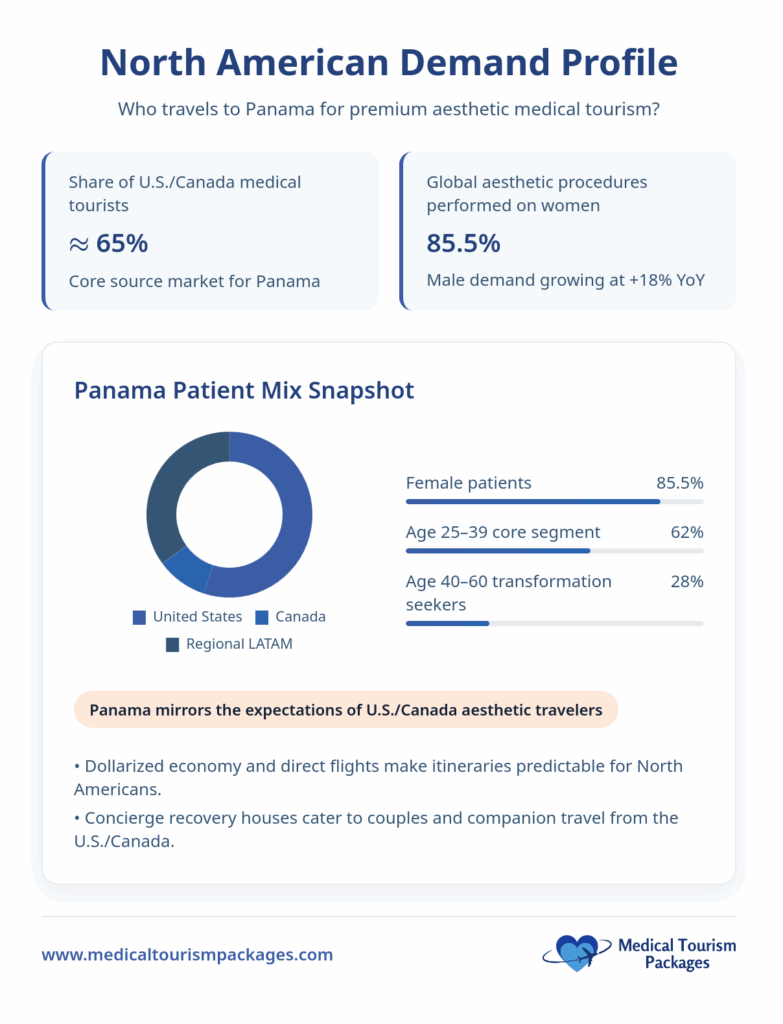
North American patients benefit particularly from the dollarized economy eliminating all currency risk. Financial predictability for budgeting removes the speculation element present in peso-based markets. Five-hour direct flights and modern infrastructure provide convenient access. English-speaking medical staff reduce communication barriers and anxiety.
Patients seeking multiple procedures maximize value through mommy makeover or comprehensive body contouring packages. Combining breast and body work in a single recovery period achieves 50-65% savings on comprehensive treatments compared to domestic pricing.
Flexible professionals who can accommodate 2-3 week absences find Panama logistically feasible. Remote workers, retirees with schedule flexibility, or those who can arrange extended leave from work avoid the time-constraint obstacles that make medical tourism impractical for others.
Who Should Avoid Panama and Stay Home?
Budget-driven patients seeking absolute lowest prices find Colombia offers $500-$1,500 savings over Panama’s minimums. Those willing to accept currency volatility for deeper savings may prefer Colombia or Mexico despite the financial unpredictability.
Time-constrained individuals unable to take 2-3 weeks off work face significant obstacles. Jobs with limited leave time, family obligations requiring presence, or discomfort with extended international absence make Panama impractical regardless of cost savings.
Risk-averse patients requiring immediate access to the US healthcare system may find the geographic separation too anxiety-producing. Those uncomfortable with foreign legal jurisdiction or experiencing significant anxiety about international medical care should consider whether cost savings justify the emotional stress. Complex medical conditions requiring established provider relationships may be better served by domestic care.
Ready to Start Your Journey?
If you’ve decided Panama is the right choice for your plastic surgery, proper preparation makes the difference between a successful outcome and a nightmare scenario. Use these checklists and contact information to ensure you’ve covered every critical step before traveling.
Complete This Checklist Before You Travel
Complete these critical steps before traveling to Panama:
- Surgeon verified through APCPER – Independent confirmation, not from clinic website
- JCI hospital accreditation confirmed – Surgical facility must be accredited
- Medical complication insurance purchased – Covers treatment in Panama and home country
- Standard travel insurance secured – For non-surgical emergencies
- Flexible flights booked – Allows recovery timeline adjustments
- Recovery accommodation arranged – Through verified channels
- Time off work approved – Minimum 3 weeks, more for physical jobs
- Pre-operative tests completed – Blood work, EKG, medical clearance
- Local follow-up doctor identified – Willing to provide emergency care after return
- WhatsApp downloaded – Primary communication platform for Panamanian practices
- Realistic expectations established – Through thorough consultations
- Complete budget prepared – Including flights, insurance, extended stay possibilities, personal expenses
Important Contact Information for Panama Surgery
For surgeon verification, contact APCPER (Asociación Panameña de Cirugía Plástica Estética y Reconstructiva) through the Colegio Médico de Panamá. The two JCI-accredited hospitals are Hospital Punta Pacifica, which holds the Johns Hopkins affiliation, and Clinica Hospital San Fernando. The US Embassy in Panama can be reached at +507 317-5000 for emergency assistance.
How to Start Your Panama Surgery Journey
Begin by researching surgeons meeting APCPER membership and ideally FACS or FRCSC certification criteria. Schedule virtual consultations three months before your intended travel date. Verify all credentials independently through official sources rather than accepting marketing claims.
Compare itemized quotes from JCI-accredited facilities only, refusing any offers from non-accredited clinics regardless of price. Purchase medical complication insurance before making any deposits or financial commitments. Book all appointments through verified channels with written confirmation of dates, procedures, and costs. Prepare comprehensively using the three-month timeline checklist provided earlier.
The three-month timeline may seem lengthy, but it ensures proper vetting, adequate preparation, and access to quality surgeons. Attempting to compress this timeline often results in settling for less qualified surgeons or inadequate preparation, significantly increasing complication risks.
Ready to discuss your options? Contact Medical Tourism Packages to connect with verified surgeons and JCI-accredited facilities in Panama. Our team helps coordinate every aspect of your medical journey from initial consultation through post-operative follow-up.
Frequently Asked Questions
Why is Panama more expensive than Colombia for plastic surgery?
Panama intentionally positions itself at the high end of regional pricing—typically $500–$1,500 above Colombia’s minimums. The premium reflects investment in JCI-accredited facilities, Johns Hopkins Medicine International affiliations, tighter regulation (FDA/EMA-only products), and complete currency stability via dollarization. You’re trading rock-bottom prices for stronger quality assurance and financial predictability.
How much can I actually save getting plastic surgery in Panama?
Most patients save 50%–70% versus U.S. prices even after travel. Example: breast augmentation at $8,000–$10,000 in the U.S. is $3,000–$5,000 in Panama; a tummy tuck at $8,500–$12,000 is $3,500–$6,500. Savings come from lower overhead, liability, and labor costs while maintaining comparable clinical standards.
What makes Panama’s use of the U.S. dollar so important?
Dollarization removes exchange-rate risk. A $5,000 quote stays $5,000 with no conversion fees. In contrast, peso volatility in Colombia or Mexico (often 15%–30%) can swing final costs by hundreds or thousands if rates move before payment. Panama eliminates that uncertainty.
How many surgeons in Panama hold top credentials?
Only 12 surgeons hold elite credentials such as FACS (American College of Surgeons) or FRCSC (Royal College of Surgeons of Canada). Because supply is limited, plan to book roughly three months ahead and verify credentials through APCPER.
What exactly is included in all-inclusive Panama packages?
Included: surgical fees (surgeon, anesthesiologist, OR, facility), 7–14 nights recovery lodging with nursing support, post-op care (lymphatic drainage, massages, follow-ups, compression garments, wound care, initial meds), and local transportation (airport and medical visits). Not included: international flights, complication insurance, standard travel insurance, most meals, personal expenses, visas, revisions, or treatment of complications. Always request itemized quotes.
Do I really need special insurance for surgery abroad?
Yes—non-negotiable. Standard travel insurance excludes elective surgery complications. Purchase dedicated medical tourism insurance with at least $25,000 in coverage (more is better) lasting 180+ days post-op. Expect ~$150–$300 for comprehensive coverage; it can prevent bills that erase all savings and create major financial risk.
How long must I stay in Panama after surgery?
Plan on 7–14 days depending on procedure and healing. Breast augmentation often allows 7–10 days; abdominoplasty or BBL typically requires at least 14 days. Surgeons clear travel based on your progress—most patients with major procedures fly between days 11–13 to reduce DVT and wound-healing risks.
What happens if complications arise after I return home?
Complications at home can be difficult: some local providers refuse overseas cases and U.S. revisions can cost more than the original surgery. Mitigate by arranging weekly telemedicine with your Panama surgeon for the first month, confirming a local doctor for emergencies, and obtaining English surgical notes, operative reports, and detailed post-op instructions with warning signs.
Is getting plastic surgery in Panama actually worth it?
It’s a strong choice for safety-focused patients who value accreditation, currency stability, and bundled care—especially if combining multiple procedures and able to stay 2–3 weeks. It’s less ideal for the most budget-sensitive (Colombia may be $500–$1,500 cheaper), those unable to take extended time off, or anyone needing immediate access to the U.S. system. The decision depends on your priorities and risk tolerance.
